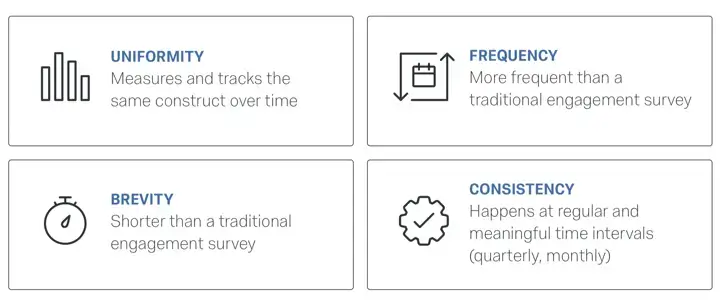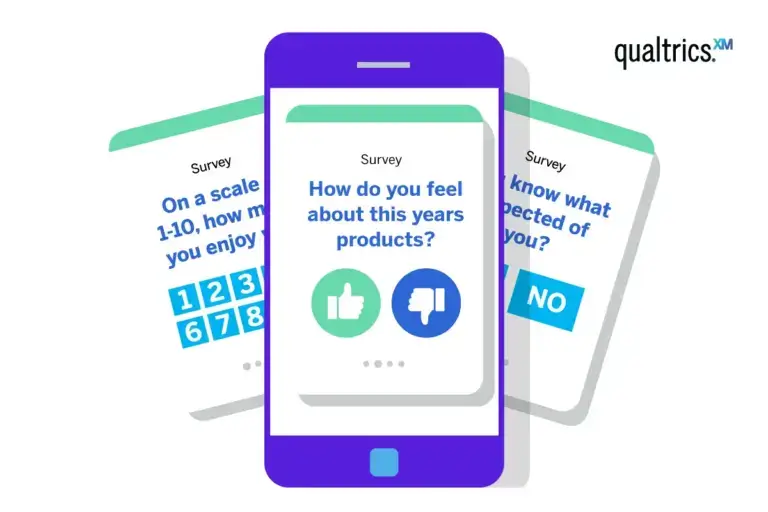
11 min read
Pulse surveys are becoming increasingly popular for employee feedback. Most people understand that they are shorter and more frequent than an annual engagement survey, but there is still confusion about what the term ‘pulse survey’ means, exactly.
Happen at a regular interval (most organizations use them quarterly or monthly)

Pulse surveys are just one of a number of different employee feedback mechanisms you could choose to use outside of an engagement survey.
Pulse surveys are popular, not only because they are shorter and reduce the amount of time it takes employees to give their feedback, but also because they introduce a new dimension to results analysis: tracking over time.
Where an annual engagement survey is a once-a-year snapshot of your employees’ engagement, pulses allow you to track items month-to-month or quarter-to-quarter so you can:
Pulse surveys are also more agile than traditional, infrequent survey methods. Asking for feedback once a year means it’s incredibly difficult to check in on the progress of action plans, as well as being difficult to align feedback measurements with business outcomes.
With pulse, employees have the opportunity to provide feedback more frequently, and organizations have the chance to react more quickly to that feedback.
Our research shows that employees want to provide feedback more regularly:
Employees feel valued and heard when they have the opportunity to provide more frequent feedback. People are 12 times more likely to recommend their employer if they feel like their feedback is being listened to and actioned.
Pulse surveys can be used to measure anything that matters to employees and the business, including:
The short answer is: anything! Pulse surveys are a non-content-specific feedback method. What you ask can be tailored to your organization’s priorities, goals, and what you need to track.
In fact, the only content-related mandate for a pulse is to have some consistency, so you’re able to track the same item over time and see how it changes from one month or quarter to the next.
That said, we do see synergies in the types of content organizations choose to measure with their employee pulse surveys.
Once you’ve identified your need for pulse surveys, they can be a valuable tool to bring the voice of employees into business decisions more regularly, which will enhance the overall employee experience.
There are no set questions as a pulse survey should be a strategic addition to your overall employee listening strategy.
Any pulse survey program requires an investment of time from your employees and your resources, so you should focus on only asking about things that are relevant, and important to your organization.
Start with the organization’s strategic priorities, then consider the HR department’s goals. One of the biggest mistakes organizations make is failing to include either outcomes or drivers in the survey.
For example, measuring only engagement will tell you nothing about why employees are engaged or disengaged, thereby making the survey unactionable.
When structuring your survey, we recommend using the 70:20:10 rule of thumb:
From there, consider including the following measurements:
That the more frequent the pulse survey is administered, the shorter it should be, e.g:

Two questions to ask are:
There are then four things to consider:
How much does what you’re measuring fluctuate? Something like employee mood may fluctuate frequently, so you could measure daily or maybe more than once per day. However, if you’re measuring employee engagement, and its drivers, levels are unlikely to fluctuate in a short period of time, and daily or weekly measurements do not make sense.
An employee survey sets the expectation that leaders will use the results to take action. Failure to do this creates feelings of distrust and disengagement among employees and is a surefire way to decrease future survey response rates.
How often can your organization react to survey results? You should be prepared to review each set of results and aim to understand them. When considering a suitable cadence for your pulse survey, think about how you’re going to be able to process and use the findings.
Action does not necessarily follow from every pulse survey (a pulse check on the effectiveness of earlier action plans may show that additional action is not needed) but it’s important to plan for possible actions following each pulse survey. A business needs to at least factor in time to review, communicate, and decide on actions.
Some organizations work quarter-to-quarter, some month-to-month and for others, everything revolves around the annual meeting.
In your pulse planning ask what the business needs the data for.
We find that quarterly is a popular pulse cadence because:
Some organizations have reservations that their employees will suffer from survey fatigue by receiving surveys more frequently.
We have found that the biggest impact on fatigue is not so much survey frequency, it’s program communication: if employees don’t hear back about their feedback, or if communication is not managed well.
Ready to take your employees' pulse? Take a look at our pulse survey software